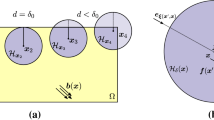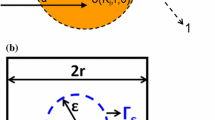Abstract
Peridynamics has attractive features for solving several fracture mechanics problems. On the other hand, to ensure the accuracy, a large amount of particles (material points) is required. Introduction of variable horizon is an alternative approach by changing the horizon size over the problem domain. In the present study, we propose a novel variable horizon concept. It is known that an undesired “ghost” force arises along the transition region of different horizons. In order to suppress the ghost force, the gradual variation in the horizon size over a certain region, called smoothing length, is introduced between different scale particle distributions. Efficiency of the smoothed variable horizon peridynamics is demonstrated by several numerical studies employing the ordinary state-based peridynamics. As a basic case, a linear displacement field is considered. It is observed that the proposed approach significantly reduces the ghost forces along the interface of different spatial discretizations. Additionally, the dynamic stress intensity factors of stationary cracks are carefully examined. The path independence of the fracture parameters in the variable horizon peridynamics is ensured. The efficiency of the presented method is then discussed. It is monitored that introduction of the smoothing length concept significantly reduces the computational costs in the peridynamic modeling.






















Similar content being viewed by others
References
Silling, S.A.: Reformulation of elasticity theory for discontinuities and long-range forces. J. Mech. Phys. Solids 48, 175–209 (2000)
Ha, Y.D., Bobaru, F.: Studies of dynamic crack propagation and crack branching with peridynamics. Int. J. Fract. 162, 229–244 (2010)
Imachi, M., Tanaka, S.: Dynamics stress intensity factors evaluation employing ordinary state-based peridynamics. Trans. JSCES. 20160017, (2016) (in Japanese)
Imachi, M., Tanaka, S., Bui, T.Q.: Mixed-mode dynamic stress intensity factors evaluation using ordinary state-based peridynamics. Theor. Appl. Fract. Mech. 93, 97–104 (2018)
Imachi, M., Tanaka, S., Bui, T.Q., Oterkus, S., Oterkus, E.: A computational approach based on ordinary state-based peridynamics with new transition bond for dynamic fracture analysis. Eng. Fract. Mech. 206, 359–374 (2019)
Imachi, M., Tanaka, S., Ozdemir, M., Bui, T.Q., Oterkus, S., Oterkus, E.: Dynamic crack arrest analysis by ordinary state-based peridynamics. Int. J. Fract. 221, 155–169 (2020)
Ozdemir, M., Kefal, A., Imachi, M., Tanaka, S., Oterkus, E.: Dynamic fracture analysis of functionally graded materials using ordinary state-based peridynamics. Compos. Struct. 244, 112296 (2020)
Silling, S.A., Littlewood, D.J., Seleson, P.D.: Variable horizon in a peridynamic medium. Sandia Report. (2014)
Dipasquale, D., Zaccariotto, M., Galvanetto, U.: Crack propagation with adaptive grid refinement in 2D peridynamics. Int. J. Fract. 190, 1–22 (2014)
Song, Y., Yan, J., Li, S., Kang, Z.: Peridynamic modeling and simulation of ice craters by impact. Comput. Model. Eng. Sci. 121, 465–492 (2019)
Ren, H., Zhuang, X., Cai, Y., Rabczuk, T.: Dual-horizon peridynamics. Int. J. Numer. Method Eng. 108, 1451–1476 (2016)
Ren, H., Zhuang, X., Cai, Y., Rabczuk, T.: Dual-horizon peridynamics: a stable solution to varying horizons. Comput. Meth. Appl. Mech. Eng. 318, 762–782 (2017)
Ren, H., Zhuang, X., Rabczuk, T.: Implementation of GTN model in dual-horizon peridynamics. Procedia Eng. 197, 224–232 (2017)
Rabczuk, T., Ren, H.: A peridynamics formulation for quasi-static fracture and contact in rock. Eng. Geol. 225, 42–48 (2017)
Tong, Q., Li, S.: Multiscale coupling of molecular dynamics and peridynamics. J. Mech. Phys. Solids 95, 169–187 (2016)
Jenabidehkordi, A., Rabczuk, T.: The multi-horizon peridynamics. Comput. Model. Eng. Sci. 121, 493–500 (2019)
Nikpayam, J., Kouchakzadeh, M.A.: A variable horizon method for coupling meshfree peridynamics to FEM. Comput. Meth. Appl. Mech. Eng. 355, 308–322 (2019)
Zhang, H., Li, H., Ye, H., Zheng, Y., Zhang, Y.: A coupling extended multiscale finite element and peridynamic method for modeling of crack propagation in solids. Acta Mech. 230, 3667–3692 (2019)
Khodabakhshi, P., Reddy, J.N., Srinivasa, A.: A nonlocal fracture criterion and its effect on the mesh dependency of GraFEA. Acta Mech. 230, 3593–3612 (2019)
Bessa, M.A., Foster, J.T., Belytschko, T., Liu, W.K.: A meshfree unification: reproducing kernel peridynamics. Comput. Mech. 53, 1251–1264 (2014)
Tanaka, S., Suzuki, H., Sadamoto, S., Okazawa, S., Yu, T.T., Bui, T.Q.: Accurate evaluation of mixed-mode intensity factors of cracked shear-deformable plates by an enriched meshfree Galerkin formulation. Arch. Appl. Mech. 87, 279–298 (2017)
Tanaka, S., Dai, M.J., Sadamoto, S., Yu, T.T., Bui, T.Q.: Stress resultant intensity factors evaluation of cracked folded structures by 6DOFs flat shell meshfree modeling. Thin-Walled Struct. 144, 106285 (2019)
Dai, M.J., Tanaka, S., Sadamoto, S., Yu, T.T., Bui, T.Q.: Advanced reproducing kernel meshfree modeling of cracked curved shells for mixed-mode stress resultant intensity factors. Eng. Fract. Mech. 233, 107012 (2020)
Ozdemir, M., Tanaka, S., Sadamoto, S., Yu, T.T., Bui, T.Q.: Numerical buckling analysis for flat and cylindrical shells including through crack employing effective reproducing kernel meshfree modeling. Eng. Anal. Bound. Elem. 97, 55–66 (2018)
Sadamoto, S., Ozdemir, M., Tanaka, S., Bui, T.Q., Okazawa, S.: Finite rotation meshfree formulation for geometrically nonlinear analysis of flat, curved and folded shells. Int. J. Non. Lin. Mech. 119, 103300 (2020)
Belytschko, T., Gu, L., Lu, Y.Y.: Fracture and crack growth by element free Galerkin methods. Model. Simul. Mater. Sci. Eng. 2, 519–534 (1994)
Liu, W.K., Chen, Y.: Wavelet and multiple scale reproducing kernel methods. Int. J. Numer. Meth. Fluid. 21, 901–931 (1995)
Liu, W.K., Li, S., Belytschko, T.: Moving least-square reproducing kernel methods (I) methodology and convergence. Comput. Meth. Appl. Mech. Eng. 143, 113–154 (1997)
Silling, S.A., Epton, M., Weckner, O., Xu, J., Askari, E.: Peridynamic states and constitutive modeling. J. Elasticity 88, 151–184 (2007)
Le, Q.V., Chan, W.K., Schwartz, J.: A two-dimensional ordinary, state-based peridynamic model for linearly elastic solids. Int. J. Numer. Meth. Eng. 98, 547–561 (2014)
Nikravesh, S., Gerstle, W.: Improved state-based peridynamic lattice model including elasticity, plasticity and damage. Comput. Model. Eng. Sci. 116, 323–347 (2018)
Bobaru, F., Yang, M., Alves, L.F., Silling, S.A., Askari, E., Xu, J.: Convergence, adaptive refinement, and scaling in 1D peridynamics. Int. J. Numer. Meth. Eng. 77, 852–877 (2009)
Cheng, Z., Wang, Z., Luo, Z.: Dynamic fracture analysis for shale material by peridynamic modelling. Comput. Model. Eng. Sci. 118, 509–527 (2019)
Rice, J.R.: A path independent integral and the approximate analysis of strain concentration by notches and cracks. J. Appl. Mech. 35, 379–386 (1968)
Li, F.Z., Shih, C.F., Needleman, A.: A comparison of methods for calculating energy release rates. Eng. Fract. Mech. 21, 405–421 (1985)
Shih, C.F., Moran, B., Nakamura, T.: Energy release rate along a three-dimensional crack front in a thermally stressed body. Int. J. Fract. 30, 79–102 (1986)
Nakamura, T., Shih, C.F., Freund, L.B.: Analysis of a dynamically loaded three-point-bend ductile fracture specimen. Eng. Fract. Mech. 25, 323–339 (1986)
Lancaster, P., Salkauskas, K.: Surfaces generated by moving least squares methods. Math. Comput. 37, 141–158 (1981)
Freund, L.B.: Dynamic Fracture Mechanics. Cambridge Monographs on Mechanics, Cambridge (1990)
Acknowledgements
The present research was partially supported by the JSPS Grant-in-Aid for JSPS Fellows (19J14053) and Grants-in-Aid for Scientific Research (C)(18K04582), which the authors gratefully acknowledge.
Author information
Authors and Affiliations
Corresponding author
Additional information
Publisher's Note
Springer Nature remains neutral with regard to jurisdictional claims in published maps and institutional affiliations.
Rights and permissions
About this article
Cite this article
Imachi, M., Takei, T., Ozdemir, M. et al. A smoothed variable horizon peridynamics and its application to the fracture parameters evaluation. Acta Mech 232, 533–553 (2021). https://doi.org/10.1007/s00707-020-02863-9
Received:
Revised:
Accepted:
Published:
Issue Date:
DOI: https://doi.org/10.1007/s00707-020-02863-9




